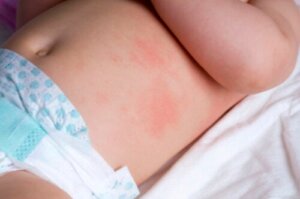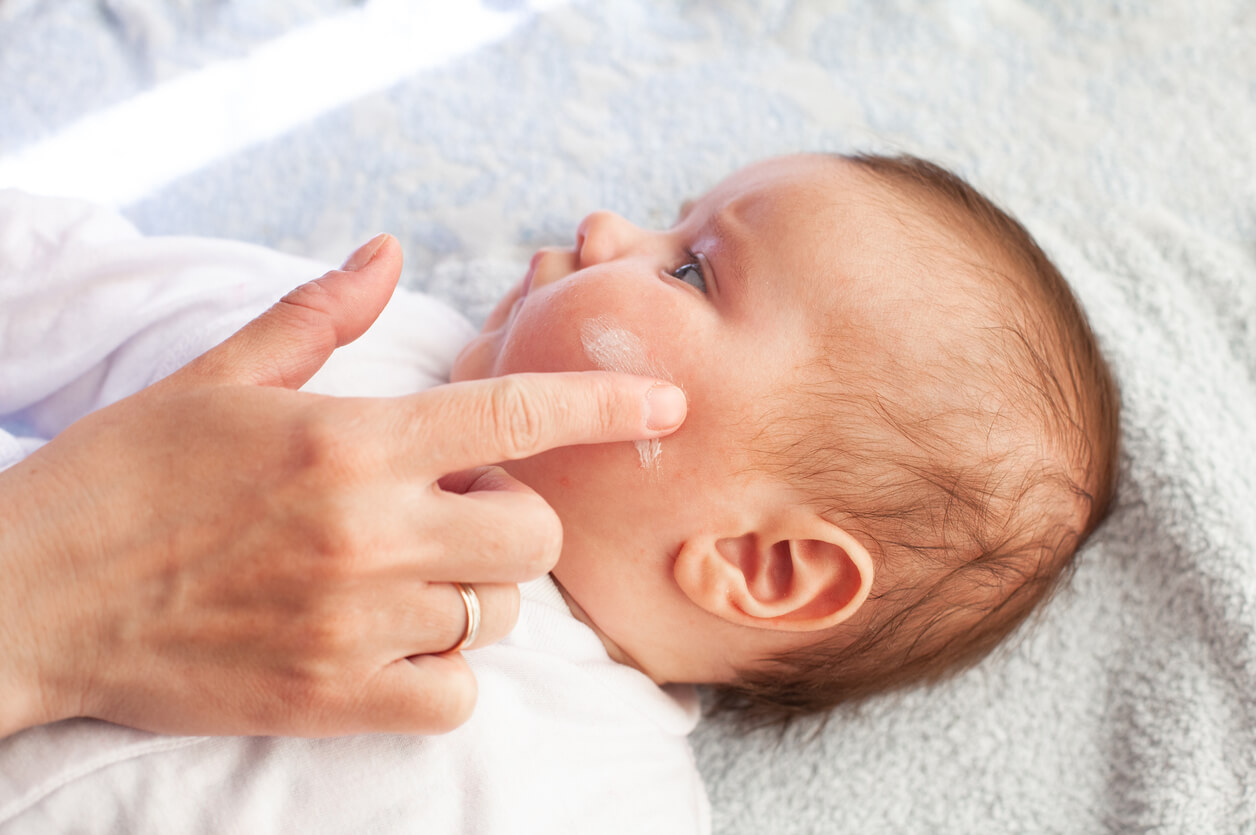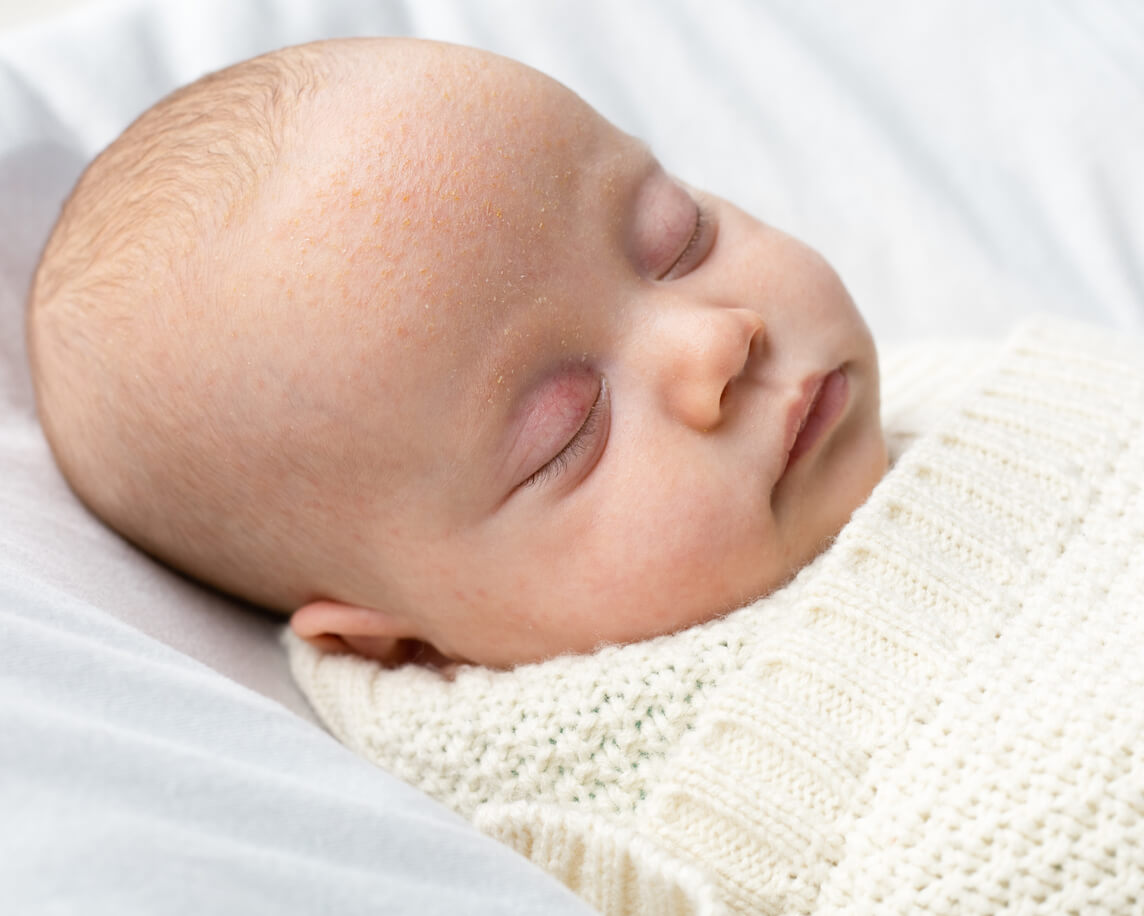Types of Rashes in Infants and How to Treat Them


Written and verified by the dermatologist Maria del Carmen Hernandez
The skin of newborns is more delicate and sensitive than that of adults and, therefore, it’s more vulnerable to rashes. When they occur on the skin surface, they’re still lesions that, if not treated properly and in time, can lead to skin infections. Keep reading to learn more about rashes in infants.
What are rashes in infants?
Rashes are lesions found on the skin of the buttocks, genitals, or thighs. In addition, they manifest as redness, blotches, or swelling. They may even feel warm to the touch, a clinical sign of inflammation.
This can cause the baby to be irritable, easily prone to crying, and wake up quite easily at night. That’s why it’s always best to make sure the diaper size is correct and to change it at least 5 times a day.
You may be interested in: My Baby Has Reactive Skin
Types of rashes in infants
Rashes can be generated anywhere on the body, although they’re most often seen in the diaper region. The rubbing of clothing can cause dermatitis even in the folds and back.

Contact dermatitis
This type of skin manifestation is quite common during childhood. In turn, it has two forms differentiated by their cause: Irritant or allergic. The lesions that may occur are polymorphic, both in relation to the outbreak of dermatitis and to the different substances responsible. Even the location of the lesions is associated with the area of direct contact, due to the fact that the skin of small children has a thinner corneal surface than that of an adult.
Diaper rash
Diaper dermatitis is an inflammatory reaction of the skin surface of the perianal and perineal areas, better known as the diaper area. According to Canadian family physician Medecin de famille canadien, it’s one of the most frequently occurring rashes in infants.
Although diaper rash is usually a mild and self-resolving condition, it requires minimal intervention to prevent it from progressing to a major infection. Skin findings include papules, erythema, erosions, and scaling. These usually occur around the scrotum, thighs, buttocks, and suprapubic area.
Causes may be due to the following factors:
- Chemical irritation
- Candida Albicans infection
- Atopy
Allergic dermatitis
Atopic dermatitis is a relapsing, chronic, and very itchy skin condition caused by the alteration of the skin’s protective barrier and its immune dysregulation. It usually occurs in early childhood and its characteristic distribution depends on the age of the sufferer. That is, on the face, scalp, and extensor regions in infants.
Acute manifestations are characterized by pruritic papules with erythema, excoriations, and serous exudate. However, pruritus and xerosis are the main symptoms.
Seborrheic dermatitis
Seborrheic dermatitis in infants appears in the form of thick flakes of skin resembling dandruff on the scalp. However, this type of dermatitis, called cradle cap, is harmless and doesn’t require any treatment. Moreover, it’s a disease that doesn’t cause itching but can spread to the face, neck, diaper area, and skin folds.

How to treat rashes in infants?
It’s best to prevent the generation of rashes in infants in order to avoid suffering and having to resort to subsequent treatments. Rashes in infants can cause inflammation, irritation, redness, or discomfort in infants. Therefore, here are some measures to follow to resolve them quickly:
- Keep the infant sanitized and dry.
- Don’t generate friction when drying the skin.
- Use light and cotton clothes.
- Change diapers more often.
- Use specific hypoallergenic moisturizing creams for babies.
- Keep the infant’s nails short to avoid scratching.
- Use products that are non-abrasive and don’t contain alcohol or fragrances.
Diaper rash in infants and medical consultation
In case of diaper rash injuries, always consult a specialist doctor to start treatment with a specific product. In these cases, the use of home or natural remedies isn’t recommended because, as babies have much thinner skin that isn’t fully developed, there’s a greater likelihood of adverse effects due to greater absorption.
The skin of newborns is more delicate and sensitive than that of adults and, therefore, it’s more vulnerable to rashes. When they occur on the skin surface, they’re still lesions that, if not treated properly and in time, can lead to skin infections. Keep reading to learn more about rashes in infants.
What are rashes in infants?
Rashes are lesions found on the skin of the buttocks, genitals, or thighs. In addition, they manifest as redness, blotches, or swelling. They may even feel warm to the touch, a clinical sign of inflammation.
This can cause the baby to be irritable, easily prone to crying, and wake up quite easily at night. That’s why it’s always best to make sure the diaper size is correct and to change it at least 5 times a day.
You may be interested in: My Baby Has Reactive Skin
Types of rashes in infants
Rashes can be generated anywhere on the body, although they’re most often seen in the diaper region. The rubbing of clothing can cause dermatitis even in the folds and back.

Contact dermatitis
This type of skin manifestation is quite common during childhood. In turn, it has two forms differentiated by their cause: Irritant or allergic. The lesions that may occur are polymorphic, both in relation to the outbreak of dermatitis and to the different substances responsible. Even the location of the lesions is associated with the area of direct contact, due to the fact that the skin of small children has a thinner corneal surface than that of an adult.
Diaper rash
Diaper dermatitis is an inflammatory reaction of the skin surface of the perianal and perineal areas, better known as the diaper area. According to Canadian family physician Medecin de famille canadien, it’s one of the most frequently occurring rashes in infants.
Although diaper rash is usually a mild and self-resolving condition, it requires minimal intervention to prevent it from progressing to a major infection. Skin findings include papules, erythema, erosions, and scaling. These usually occur around the scrotum, thighs, buttocks, and suprapubic area.
Causes may be due to the following factors:
- Chemical irritation
- Candida Albicans infection
- Atopy
Allergic dermatitis
Atopic dermatitis is a relapsing, chronic, and very itchy skin condition caused by the alteration of the skin’s protective barrier and its immune dysregulation. It usually occurs in early childhood and its characteristic distribution depends on the age of the sufferer. That is, on the face, scalp, and extensor regions in infants.
Acute manifestations are characterized by pruritic papules with erythema, excoriations, and serous exudate. However, pruritus and xerosis are the main symptoms.
Seborrheic dermatitis
Seborrheic dermatitis in infants appears in the form of thick flakes of skin resembling dandruff on the scalp. However, this type of dermatitis, called cradle cap, is harmless and doesn’t require any treatment. Moreover, it’s a disease that doesn’t cause itching but can spread to the face, neck, diaper area, and skin folds.

How to treat rashes in infants?
It’s best to prevent the generation of rashes in infants in order to avoid suffering and having to resort to subsequent treatments. Rashes in infants can cause inflammation, irritation, redness, or discomfort in infants. Therefore, here are some measures to follow to resolve them quickly:
- Keep the infant sanitized and dry.
- Don’t generate friction when drying the skin.
- Use light and cotton clothes.
- Change diapers more often.
- Use specific hypoallergenic moisturizing creams for babies.
- Keep the infant’s nails short to avoid scratching.
- Use products that are non-abrasive and don’t contain alcohol or fragrances.
Diaper rash in infants and medical consultation
In case of diaper rash injuries, always consult a specialist doctor to start treatment with a specific product. In these cases, the use of home or natural remedies isn’t recommended because, as babies have much thinner skin that isn’t fully developed, there’s a greater likelihood of adverse effects due to greater absorption.
All cited sources were thoroughly reviewed by our team to ensure their quality, reliability, currency, and validity. The bibliography of this article was considered reliable and of academic or scientific accuracy.
- American Academy of Allergy, Asthma and Immunology; American College of Allergy, Asthma and Immunology. Contact dermatitis: a practice parameter. Ann Allergy Asthma Immunol. 2006 Sep;97(3 Suppl 2):S1-38. Erratum in: Ann Allergy Asthma Immunol. 2006 Dec;97(6):819. Beltrani, Vincent S [removed]; Bernstein, I Leonard [removed]; Cohen, David E [removed]; Fonacier, Luz [removed]. PMID: 17039663.
- Kellen PE. Diaper dermatitis: differential diagnosis and management. Can Fam Physician. 1990 Sep;36:1569-72. PMID: 21233927; PMCID: PMC2280139.
- Schneider L, Tilles S, Lio P, Boguniewicz M, Beck L, LeBovidge J, Novak N, Bernstein D, Blessing-Moore J, Khan D, Lang D, Nicklas R, Oppenheimer J, Portnoy J, Randolph C, Schuller D, Spector S, Tilles S, Wallace D. Atopic dermatitis: a practice parameter update 2012. J Allergy Clin Immunol. 2013 Feb;131(2):295-9.e1-27. doi: 10.1016/j.jaci.2012.12.672. PMID: 23374261.
-
InformedHealth.org [Internet]. Cologne, Germany: Institute for Quality and Efficiency in Health Care (IQWiG); 2006-. Seborrheic dermatitis: Overview. [Updated 2020 Jun 18]. Available from: https://www.ncbi.nlm.nih.gov/books/NBK532846/
This text is provided for informational purposes only and does not replace consultation with a professional. If in doubt, consult your specialist.








